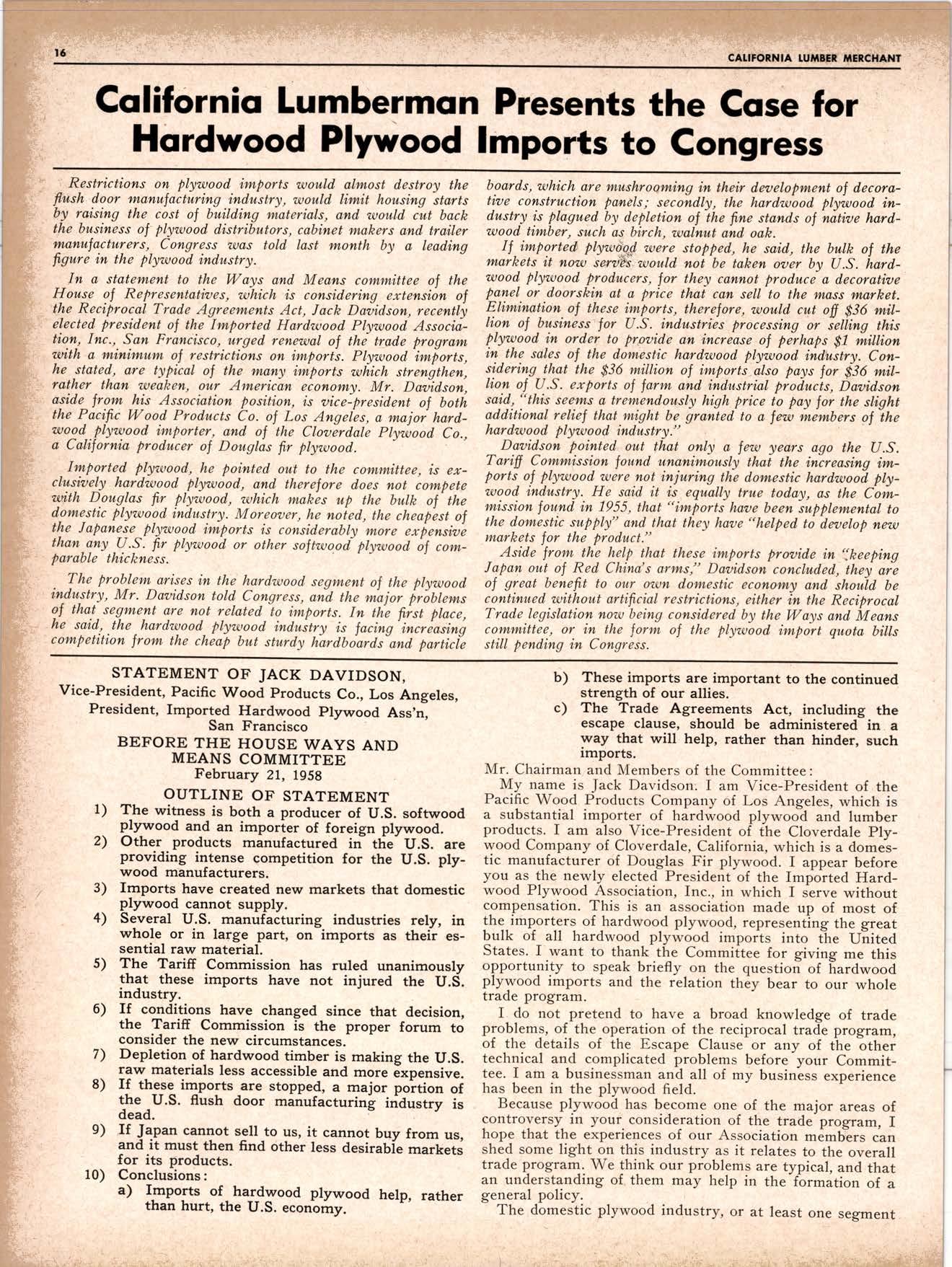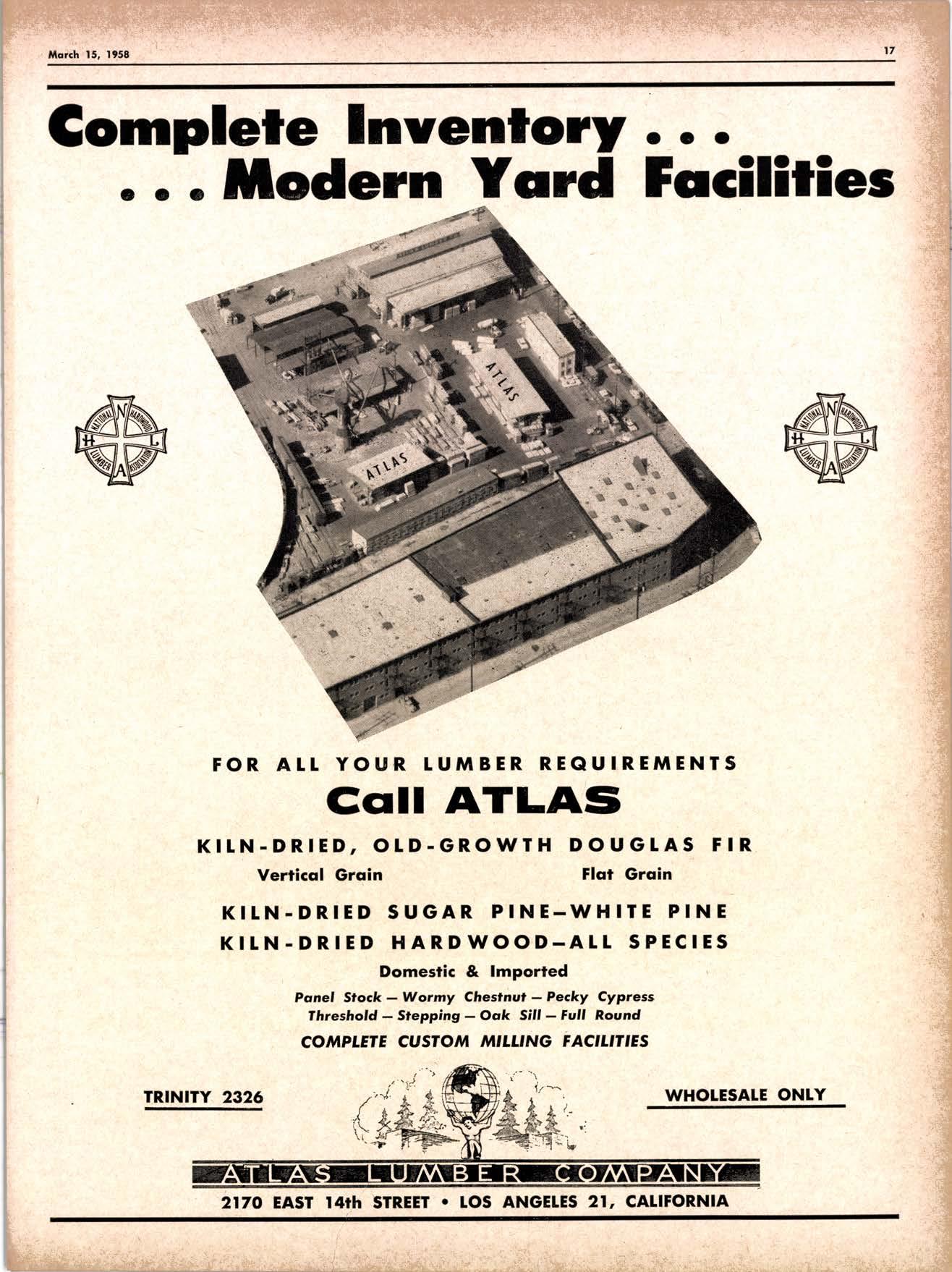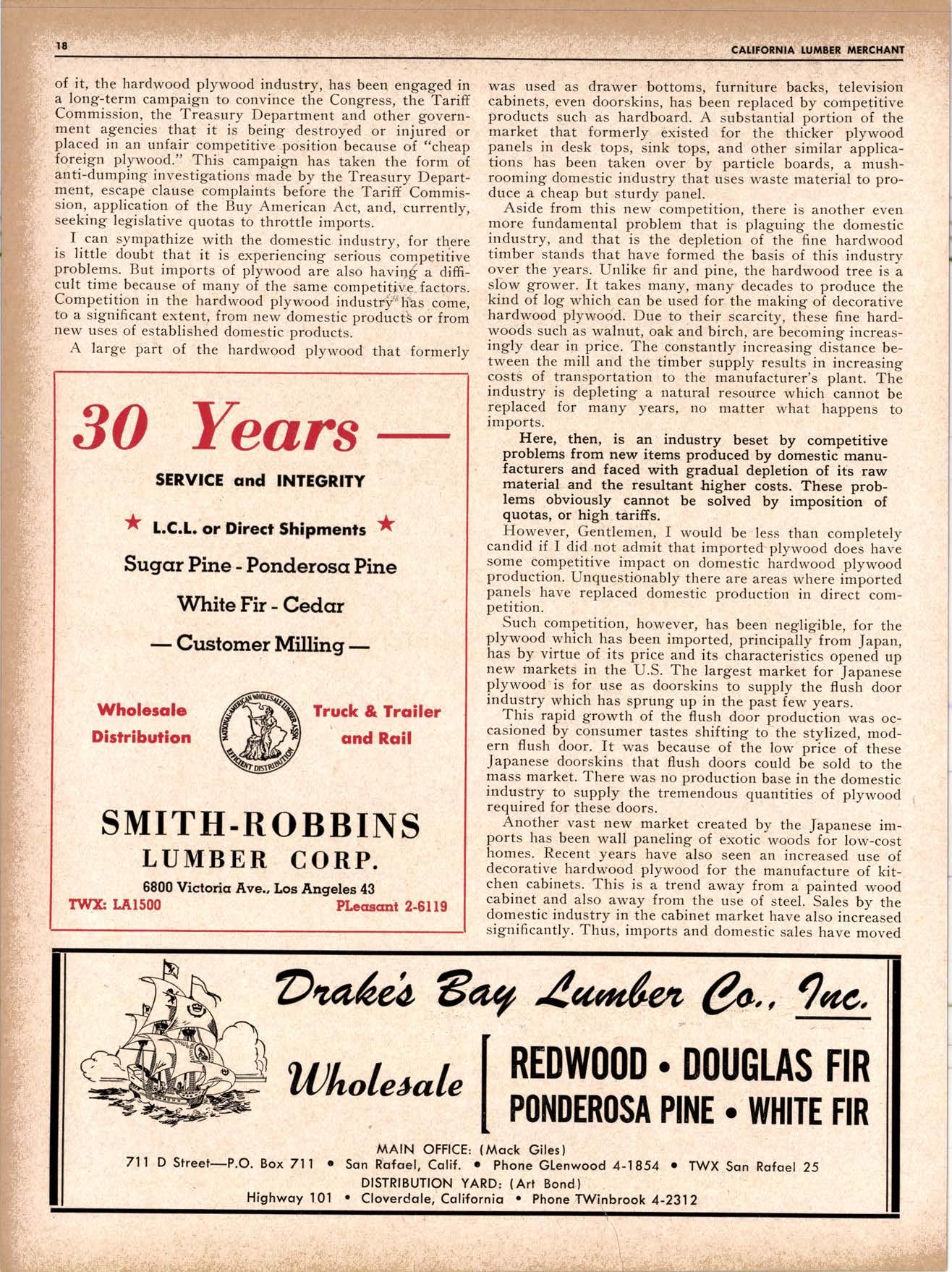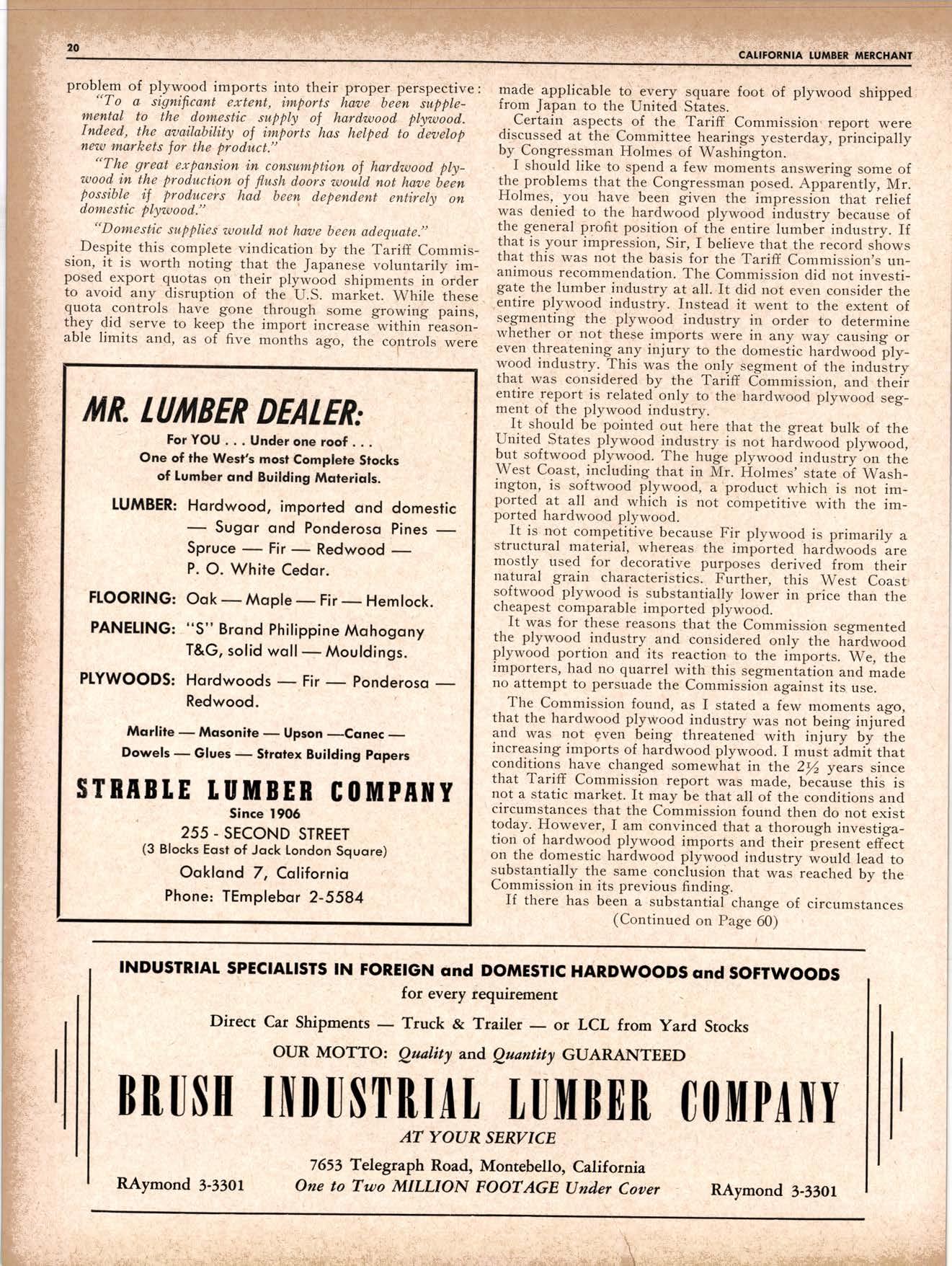
10 minute read
Coliforniq Lumbermon Presents the Cose for Hordwood Plywood lmports to Congress
bgards, whi,ch are mushroqming in their development of decoratiae construction pwtels; secondly, the hordutbod pl5naood industry is plaguedby depletion of -the fine stands ol nithte hard,wood timber, such as b,i,rch, zsalnut and oak.
If .imported plyzo\"N were stopped, he said,, the bulk of the mo,rhets it noan swvh.would, not be token ozter by U.S. hard,anod, plywood, producers, Jor they cannot produci a decoraliue panel or doorskin at o price tlnt can sell to the mass ma,rket. Eliminotion.ot these ilTrQorts, therefore, would, cr,1,t ofi $36 miJlign of business'tor U.S. industries processing or ielling this plywood ln orlei to prpaid,e an incrbase of pirhops gt inittion iry .th1 sale_s ot -the !9m,estic hardzaood plyzuiod iidrtitry. Coty.a-t"S llryt the 936 million of importi-irtso pays for dS6 m;f lion of U.S. erportu of farm and industrint pioducis, Davidson said, *this seem; a tremendously high price to pay for the stight add.i,tional-relief that.might be jranted' to a fezi mimbers gf"the hardwood plywo od ind,ustry."
_Iry.forted. plyzuood, he pointed out to the committee, is er-
, clusiaely hard,zuood plywood, and therelore d,oes not compete
'!th D.ouglas fir. ply_wood, _zahich mahbs up the bulh of'the dotne_stic plyzuood, i,nd,r1s!ry. Moreouer, he noied, the cheapbst of ' the lapanele^plywood, imports is cons,iderably more erjensiab
' than,any.,qf ii, plyzuood or other soyr*ooi ptywooa i,f ,ii- ' parable thichness.
Tht pro_blem arises'in the hard,zuood, segrnent of the plyzaood, ' industry, Mr. Davidson told- Cangress, aid the ,roio, lr6btr*,, i, ef that segrnent are not related, "to irnports. In tie fiist Olace 'r,. he said, the hardwood bl"lu,ood. induitrt ;" ne saxd, hard,wood plyu,ood. industry is facino-i.ncriasino competition from the cheap but sturdy h,ardboartls"and, particie
STATEMENT OF JACK DAVTDSON,
Vice-President, Pacific Wood products Co., Los Angeles, President, Imporled Hardwood plywood Ass'n, San Francisco
BEFORE THE HOUSE WAYS AND MEANS COMMITTEE
February ZL, LgSg OUTLINE OF STATEMENT b) These imports are important to the continued strength of our allies. c) The Trade Agreements Act, including the escape clause, sbould be administered- in. a way that will help, rather than hinder, such tmPorts.
_Dazrid_son pointed,. out lhat only a few years ago the U.S. Tarifi Commission tound, unanitnously thai the inlreasing imports of plyzuood were not injuring the domestic hardzryood plyzaood industry. He said, it is equally true today, as the Coiv ryisslon found, in 1955, that "imports have beeniupplernental to the d,o*nestic sltppl!" and, that they have "helped to d,eaetop new marbets for the product."
Aside frorn the help that these imports prwirle in likeeling Iapaqt out of Red Chinais orms," Davidson- concluded, ney ar2 of great benefit to our ozan d,omestic econorny anil should, be continued utithout artfficial restrictions, either in the Reci,brocal Trad,e legi,station now'being considerei by the Ways and iieais committee., or in-the lorm of the plyuood, i,mport quota bills still pending in Congress.
Mr. Chairman. and Members of the Committee: r) 2)
The witness is both a producer of U.S. softwood plywood and an imporler of foreisn plnwood. Other products minufactured in- tlie- U.S. are providing intense competition for the U.S. ply- wood manufacturers.
3) Imports have created new markets that domestic plywood cannot supply. +) Seve,ral U.S. manufacturing industries rely, in whole or in large part, on imports as theii essential raw matenlal.
5) The Tariff Commission has ruled unanimously that these imports have not injured the U.S. industry.
6) If co_1d1t!on9 have changed since that decision, the Tariff Commission il the proper forum to consider the new circumstances.
7) Depletion of- hardwood timber is making the U.S. raw materials less accessible and more ixpensive.
8) If th-e59 imports are stopped, a major poition of the U.S. fush door minufacturin! iridustry is dead. 9) If hp"tt canlot sell-to us, it cannot buy from us, and it must then find dther less desirabi" martet-s for its products.
10) Conclusions: a) I_mpo-rts of hqdwood plywood help, rather than hurt, the U.S. econbriry.
My name is Jack Davidson: I am Vice-President of the Pacific Wood Products Company of Los Angeles, which is a substantial importer of hardwood plywoo-d and lumber products. I am also Vice-President of ihe Cloverdale plvwood Company of Cloverdale, California, which is a dome-stic manufacturer of Douglas Fir plywood. I appear before you as_the newly elected President of the Impolted Hardwood Plywood Association, Inc., in which I serve without compensation, This is an association made up of most of the importers of hardwood plywood, representing the great bulk of all hardwood plyw6od imporls into i6e Uiitea States. f want to thank-the Commiitee for giving me this opportunity to speak briefly on the questioi of fiardwood plywood imports and the relation they bear to our whole trade program.
I do not pretend to have a broad knowledge of trade problems, of_the-operation of the reciprocal tradl program, of the details of the Escape Clause or any of the other technical and complicated problems before-your Committee. I am a businessman- a1{ all of my businbss experience has been in the plywood field.
Because plywood has become one of the major areas of controversy in your consideration of the trade-program. I hope that the experiences of our Association memblrs can shed some light on this industry as it relates to the overall trade program. We think our problems are typical, and that an understanding of, them may help in the-fbrmation of a general policy.
The domestic plywood industry, or at least one segment of_it, the hardwood plywood industry-, has bein engaged in , q long-term campaign to convince the Congress, the Tariff . Commission, the-Treasury _Department and other g.overn- iment-agencies lhat it is being destroyed or injured or


Irlaced in an unfair competitive.position-because oi ..cheap fo.reign plywood." This- campaign has taken the form oi
_a{rti-dumping investigations madl by the Treasury Depart- ment, escapd clause iomplaints bef6re the Tarifi'Co*-ir- sion,. application of the Buy American Act, and, currently,
-^^l-:---, i,,: I seeking legislative quotas to throttle imports.
I can sympathize with the domestic industry. for there is l_ittle doubt that it is experiencing seri'ous competitive problems..But imports of plywood aie also havia$'a diffi- cult time because of_ many of the Same competillv"i- factors. Competition in the hardrvood plywood industni#hUs come. to a significant extent, from new-domestic productb or from new uses of establishid domestic products.
A large pait of the hardwgod plywood that formerly i -. r:.', i ": , : rl, , " ,,.1,, I '.' ' .'. was used:ras driwer bottonis, firinittrre hacks, televisioir cabinets, even doorskins, has been replaced by corhpetitive products such as hardboard. A substanti4l portion- of the market that formerly. existed for the ;thi;ker plywood panels_ in desk tops, sink tops, and other similar applica- tions has been taken over by particle boards, a -mushrooming domestic industry thai uies waste material to produce a cheap but,sturdy panel.
Aside from this new competition, there is another even more fundamental problem that is plaguing the domestic industry, and that is the depletion of the fine hardwood timber stands that have formed the basis of this industry over the years. Unlike fir and pine, the hardwood tree is i 9lbry grgwer. It takes many, many decades to produce the kind of lqg which. can be used for the making ol decorative hardwood plywocid. Due to .their scarcity, t[ese fine hardwoods such as walnut, oak.and birch, are becoming increasingly dear in price. The constantly increasing disiance between the mill and the timber supply results in increasing costS of transportation to thb manufacturer's plant. Thi indrJstry is depleting a natural re$oubce which-cannot be rbplaced for many years, no matter what happens to rmports.
Here, then, is an industry beset by compdtitive problems from new iterns produced by domestiC lnanufacturers ahd faced with gradual depletion of iis raw mategial' and the resultant higher iosts. These prob- lems obvioudly cannot be solved by imposition of quotas, or high tariffs.
H_gygygr, Gentlernen, I would be less than completely candid if I did not admit that imported plywood doei have some compe_tltive impact on domestic hardwood plywood production. Unquesiionably there are areas where irnported panels have replaced domestic production in direct competition.
Such competition, however, has been negligible, for the plywood.which has been imported, principa-lly from Japan, has by virtue 9f iJs q1i9e arnd its chiracteristics operied up new rnarketd in the U.S. The largest market for japanes^e plywood-is {or use as doorskins to supply the flush door industry which has sprung up in the pait few years.
This ra_pid growth of the -flush door produciion was occasioled by consumer tastes shifting to--the stylized, modern flush door, It was because of the low price of these Japanese doorskins that flush doors could be sold to the mass market. There was no production base in the domestic industry to supply- the tremendous quantities of plywood required for these doors.
Another vast new market created by the Japanese imports has been wall paneling of exotic woodj for low-cost homes. Recent years have also seen an increased use of decorative hardwood plywood for the manufacture of kitchen cabinets. This is a trend away from a painted wood cabinet and also away from the usl of steel.-Sales by the domestic industry in the cabinet market have also incr-eased significantly. Thus, imports and domestic sales have moved hancl-in-l-rarrcl in the clevelopment of this uelr, urarket' There I,ras bee' a steacll, grou'th in tl.re rnarrrrfact're of hortse trailers, sales lasi )'.rr, "-o.lnting to or.er $600,000,000' In.rports have alsci .sharecl u'ith tlie clomestic inch'lstry irl pto"i,littg pl)'n'ood 1>anelir-rg for the interiors of marry of these trailers.
The cousutner has receivecl tire berlefit of these clevelopments along with the door mauttfacturer, trailer proclttce-r, home builciir arrd, cif course, the plyrvood distributor' I{ ir.nports of hartlu'o<-rcl plyrvoocl u'ere seriously curtaile<l, the clomestic inclustry miglit be able to 1i11 a small portio-n of the voi<l, but it could never satisfy the requirenlents of the great bulk of these markets. The choice here is trot betl'veen iinportecl plyrvoocl ancl domestic plywood. Before imported plvr,r''oocl was available for cloorskir.rs and paneling, builders bf" low-cost housing could not pttrchase domestic plyu''ood for tl-rese rtses clus to the cost factor, antl if imports are tlenied to ther.n they still calurot use the donlestic plywood in its place. Lorv-cost l.rousing just cannot utilize tl-re expen- sive hardwoocl plyrvood proclucecl in the U.S., srrcl'r as w.alrrut, bircl.r, oak, Africari mahogarly and other clecorative hardwoocls. If imports stoppecl, tl're great brrlk of these builders u,ortld turn to harilboard or so111e similar substittlte, or rvoulcl sirnply not ttse clecorative u'ood Paneling' This rvotrlcl provirle iiitle help to the clomestic irarcl*'oo<l olvrvoocl in cltt str v-. '

||tri. analysis of t1-te market is basecl not orrly o11 my owlr experience ind that of my associates in the plyn''ood--il-rclust.v. but it is also the urranin.rous couciusion of the U'S. Tariff Commission, wl-ricl-r spent mttch time ancl rnoney only a few years ago investigating every aspect of the harchvoocl plywoocl problem.
In the face of an admittedly great increase in plywood imports, the Commission found that these imports were not causing or threatening any injury to the domestic industry.
I would like to ieacl just a fet' excerpts from the utlanimous Tariff Cornmissiort report u'hicl-r may help put the
: problem of olvwood imports into their.Prope-r perspective: made Jpplicable- to every square foot of plywood shipped " I o_ e signilicant ertent, imports haae been supple- from Iabin to the United States. t o. e sr'g.nificant ertent, iyports -harye begn lufple; from Japin Uniteil Stlates. mental to the domesti'c -supply of- hardwood, plyzuiod. Ceriain ."p."i. ;i th; T;tiff Commission.reDort were r,.lir,i.:'i;"";;;Ay,H;:,t;li; new markets for the froduct." by Congressman Holme. oi W"rt i-neio". of imp6rts'has hetped, to ievetop discgssed
"T!t9 gr.eat erpansion in_consamption of hardzaood. ply- ' _ I should like to spend a few momJnt".rrr*ering some of Yoo4,i! the prod,,acti,gn of fl'ush doors wouid, not haae bein the.problems that the Congressman posed. npp"r8niiy, Vfi. p,osstble. if. ltrod'uc.ers had been dependent entirely on Holm_es,-you have been given the-impressi,on that"ielief d'omestxc pl,yzaaod'." was denied to the hardwobd plywood industry because of ll:-q:":itl profit position of the entire lumbei industry. If Despite this complete vindication by the Tariff Commis- that is your impression, Sir, I believe that the record shows "i"", "ii i" *.,tn "5ti"s th,i iq; J;p..";:g vorunta.rily im_ :X?h:X': ,:l:#,"1i:ffi:T;: B;#,:fl,?ffl""lil;"$_ posed export q_uotas qn their plywobd shipments in -order 'to ""oia'.,,y.ti,,"ptinn or trri'u.s. L",r..t. whle these. #li,jT,l.f;:f
"Domesbic supplies would, not haae been adequate."
,tti.l.,l]qtft'lli?f .1"il:.0*11: t'*!""X?ot"::g:"T?ilil*,"*'# causing.or cQPtrols were even threatening any i"fty to the domesiic hardwood plv- pt*:,"-1_ildustry in order t"-a"I.,,ni"" abr6 rimits '"-a,- ", tr' n;; ;;;;il
fiIR. TiUBER DEAIER:
ForYOU Underone roof . . ., One of the Wesfs most Complete Stocks of lumber ond Building Mcterials.
LUMBER: Hordwood, imported ond domesficSugor ond Pondele5q Pins5 - SpruceFirRedwood - P. O. Whire Cedor.

FIOORING: OokMopleFirflgrnl66k.
PANEIING: "S" Brond Philippine Mohogony T&G, solid woll -- /vtouldings.
PTYWOODS: Hordwoods -,Firponder Redwood.
MorliteMosoniteUpson -eqn6sDowelsGlues!1lsfsa Building popers
STN[BI.E I.UTBEN G||iTP[IIT
. Since 1906
255. SECOND STREET
(3 Blocks Eqsf of Jock London Squore)
Ooklond Z, Colifornio
Phone: TEmplebor 2-5584 wood industry. This was the onlv segment of the industiy I that was considered !y the Tariff Commission, and their entire report is related o-nly to'the,hardwood pti*ooO seiment of the plywood industry.
-.I! slroSld lie'pointed out hlre that the great bulk of the Unrted States plywood industry is not haidwood plvwood. b,ut softwood.plyw-ood. The huge plywood industry'on the West Uoast, including that in Mf. Holmes, state oi Wash_ ington, is softwood plywood, a'product which is not im- ported at all and whith is not competitive with the imported hardwood plywood.
It is not competitive because Fir plywood is primarilv a structural material, whereas the imported har<iwoods are mostly_ used for decorative purposes derived from their natural grain characteristics. Further, this West Coast, softwood plywood is substantially lower in price th";-th; cheapest comparable imported plywood.
It was tor these reasons that the Commission segmented the plywood industry and considered only the hirdwooJ plywood portion and its reaction to the imports. W"; ih; rmporters, had no quarrel with this segmentation and made no attempt to persuade the Commissioin against its, use.
The Commission found, as I stated a few moments ago, that the hardwood plywood industry was not beins iniuftd and was not gven F-.i"g threaten-ed with injur/ bf ttre rncreaslng r_mports ot hardwood plywood. I must admit that conditions have changed somewhit in the 2f yearc since that Tariff Commission report was made, beiause this is not a static market. It may be that all of the conditions and circumstances that the Commission found then do not exist today. Ilowever, I am convinced that a thorough investisa_ tion.of hardwood plywood imports and their p"resent efiEct on the domestic hardwood plywood industry ivould lead to substantially.th.e same conChision that was-reached Uy tte Uommission in its previous findine.
If there has been a substantial-change of circumstances (Continued on page 60)
Ditect Cat ShipmentsTruck & Traileror LCL from Yard Stocks OUR MOTTO: eulity and, eaantity GUARANTEED









